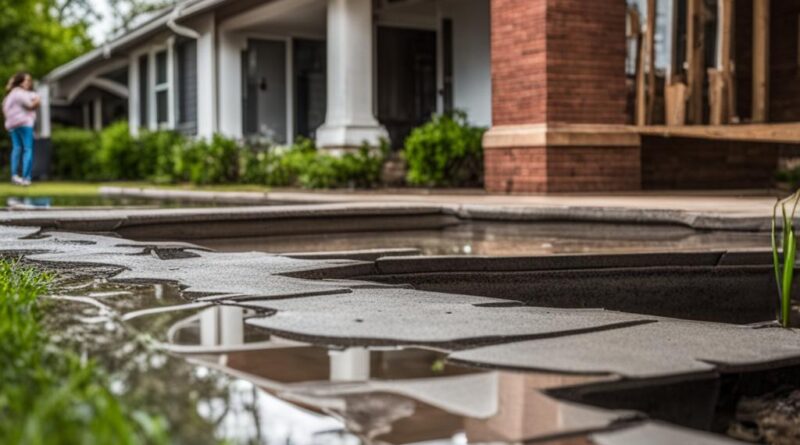Does Homeowners Insurance Cover Slab Leak Repair? Find Out!
If you’re a homeowner, you may be wondering if your insurance policy covers the cost of repairing a slab leak. A slab leak can cause significant damage to your home’s structure and belongings, so understanding your coverage is crucial. In this article, we will explore whether homeowners insurance typically includes slab leak repair and what factors may affect coverage. Read on to learn more about protecting your home from this potential threat.
Key Takeaways:
- Homeowners insurance may cover slab leak repair depending on the cause of the leak and the perils listed in your policy.
- Typically, covered perils include risks like fire, wind, explosions, and falling objects.
- Dwelling coverage can help pay for repairing the structure of your home, while personal property coverage can help pay for damaged belongings.
- Homeowners insurance generally does not cover maintenance issues or wear and tear.
- Regular maintenance and inspections can help prevent slab leaks and ensure your coverage remains intact.
Understanding Slab Leaks and Homeowners Insurance Coverage
A slab leak is a common issue that homeowners may encounter, and understanding how homeowners insurance can help cover the cost of repairs is important. A slab leak occurs when water and sewer lines beneath the concrete foundation of a home break or deteriorate, leading to water leakage. Depending on the cause of the leak, homeowners insurance may provide coverage for the necessary repairs.
When it comes to slab leaks, homeowners insurance typically covers the repair costs if the cause of the leak is a peril listed in your policy. Perils such as fire, wind, or falling objects are typically included in homeowners insurance coverage. Dwelling coverage can help pay for tearing out the damaged slab and replacing it, while personal property coverage can assist in repairing or replacing damaged belongings affected by the slab leak.
It’s essential to review your insurance policy to understand the risks and perils it covers. Some policies may have exclusions or limitations regarding slab leak coverage. Being aware of these details can help you assess whether your insurance policy provides adequate coverage for potential slab leaks. Additionally, regular maintenance and inspections of your plumbing system can help prevent slab leaks and ensure the longevity of your home.
Table: Perils Typically Covered by Homeowners Insurance for Slab Leaks
| Peril | Description |
|---|---|
| Fire | Damage caused by fire, including fire-related water damage |
| Wind | Damage caused by strong winds, such as hurricanes or tornadoes |
| Explosions | Damage caused by explosions, such as gas or chemical explosions |
| Falling Objects | Damage caused by objects falling onto the home, like trees or debris |
While homeowners insurance can provide coverage for slab leaks resulting from covered perils, it’s important to note that general maintenance issues or wear and tear are typically not covered. This means that if the slab leak is a result of gradual damage or aging pipes, the repair costs may not be covered by homeowners insurance. In such cases, homeowners may need to explore alternative options, such as separate service line coverage, which can help cover the repair costs for service lines, including plumbing, not covered by standard homeowners insurance policies.
Scenarios Where Homeowners Insurance May Cover Slab Leaks
Homeowners insurance provides coverage for a wide range of perils, including certain scenarios where slab leaks occur. Understanding these scenarios can help you determine if your insurance policy will cover the costs associated with repairing a slab leak.
Table: Covered Scenarios for Slab Leaks
| Scenario | Insurance Coverage |
|---|---|
| Tornado or Windstorm | May be covered |
| Explosion | May be covered |
| Burst Pipes | May be covered |
| Fire | May be covered |
In scenarios where a slab leak is caused by a covered peril, such as a tornado, explosion, or burst pipes, your homeowners insurance policy may provide coverage. This coverage can help pay for tearing out and replacing the damaged slab, as well as repairing any resulting water damage to your home.
However, it’s important to keep in mind that your insurance policy will have a deductible, which is the amount you must pay out of pocket before the insurance kicks in. Additionally, there may be limits to the coverage provided by your policy, so it’s essential to review the terms and conditions to understand the extent of your coverage.
By being aware of the scenarios in which your homeowners insurance may cover slab leaks, you can make informed decisions about protecting your home and finances. Consult with your insurance provider to fully understand your policy and explore any additional coverage options that may be available to you.
When Slab Leaks are Not Covered by Homeowners Insurance
While homeowners insurance can provide coverage for certain types of slab leaks, there are instances where these leaks may not be covered by your policy. It’s important to be aware of these situations to avoid any surprises when filing a claim.
One common scenario where slab leaks are not covered is when they are caused by gradual issues or wear and tear. This includes situations where tree roots damage the plumbing or when plumbing lines are past their prime. Homeowners insurance typically does not cover these maintenance-related issues.
However, it’s worth noting that you may have the option to add separate service line coverage to your homeowners insurance policy. This coverage can help pay for the repair of a service line, which includes the plumbing lines under your slab. It’s important to review your policy and consult with your insurance provider to determine if this additional coverage is available and suitable for your needs.
Table: Scenarios Where Homeowners Insurance May Not Cover Slab Leaks
| Scenario | Coverage |
|---|---|
| Slab leak caused by gradual issues or wear and tear | Not Covered |
| Tree roots damaging the plumbing | Not Covered |
| Plumbing lines past their prime | Not Covered |
Understanding the exclusions and limitations of your homeowners insurance policy is crucial when it comes to determining if slab leak repair is covered. If you’re unsure about the coverage or have any questions, it’s recommended to reach out to your insurance provider for clarification.
Detecting and Identifying Slab Leaks
Slab leaks can be a hidden and costly problem for homeowners. Detecting and identifying slab leaks early can help minimize damage and prevent further complications. Here are some signs to look out for that may indicate the presence of a slab leak:
- Increased water bills: If you notice a sudden spike in your water bills without any apparent reason, it could be a sign of a slab leak.
- The sound of water running: If you hear the sound of water running even when all the faucets and appliances are turned off, it could be a sign of a slab leak.
- Loss of water pressure: If you experience a significant drop in water pressure throughout your home, it could be due to a slab leak.
- Damp baseboards or wet carpets and floors: Moisture or water damage on your baseboards, carpets, or floors, especially if it occurs near the perimeter of your home, can indicate a slab leak.
If you notice any of these signs, it’s important to take immediate action. Hiring a professional plumber who specializes in slab leak detection is crucial in accurately identifying the location and source of the leak.
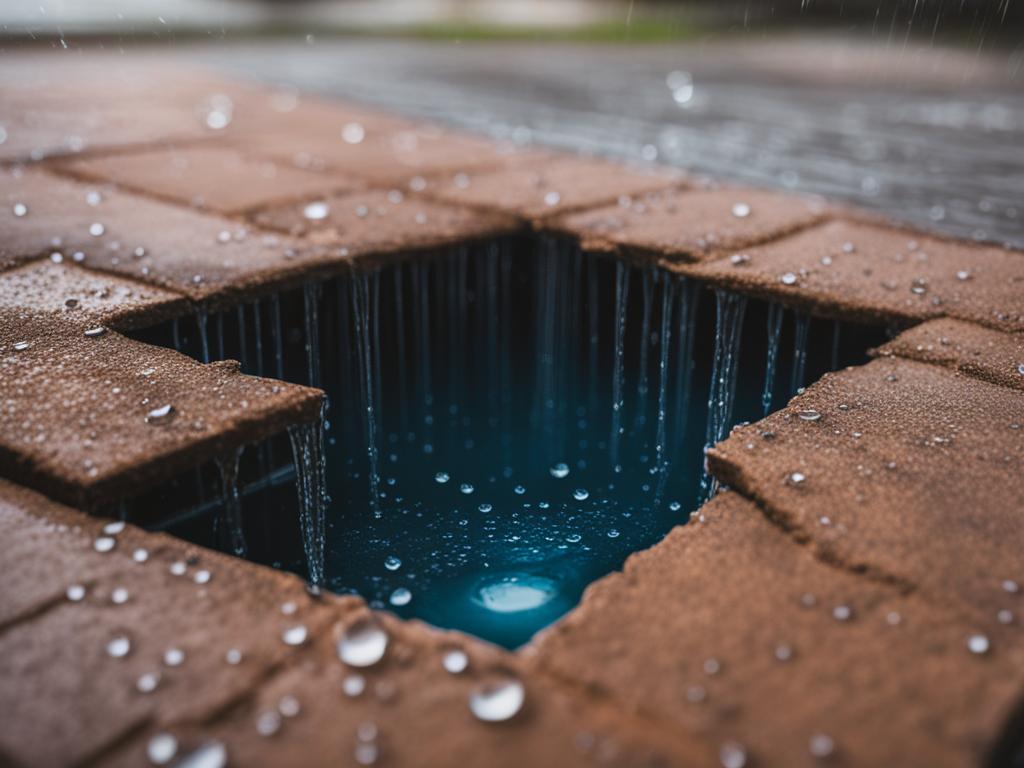
A professional plumber will use specialized equipment, such as electronic leak detection devices, to pinpoint the exact location of the leak. They may also perform a pressure test to determine the severity of the leak and assess any potential damage to the slab and surrounding areas. This thorough inspection will help guide the repair process and minimize the disruption to your home.
Preventing Slab Leaks
While it’s important to detect and address slab leaks promptly, prevention is always the best approach. Here are some measures you can take to reduce the risk of slab leaks:
- Maintain consistent moisture levels: Avoid excessive watering of outdoor landscaping near the foundation of your home, as it can cause soil expansion and put stress on the slab.
- Monitor water pressure: Excessively high water pressure can strain your plumbing system and increase the likelihood of leaks. Consider installing a pressure regulator to maintain a safe and consistent water pressure.
- Address plumbing issues promptly: If you notice any signs of plumbing problems, such as dripping faucets, running toilets, or unusual sounds, have them inspected and repaired immediately to prevent further damage.
- Insulate pipes: Properly insulating your pipes can help protect them from extreme temperatures and reduce the risk of leaks caused by freezing and thawing.
By being proactive and vigilant, you can minimize the chances of experiencing a slab leak and the associated headaches and expenses.
Cost of Repairing a Slab Leak
Repairing a slab leak can vary in cost depending on several factors. The average cost for repairing a slab leak is approximately $2,515, according to 2022 cost data. However, it’s important to note that this is just an average, and the actual cost can be higher or lower depending on specific circumstances.
There are several factors that can impact the cost of repairing a slab leak. The extent of the damage plays a significant role in determining the overall cost. If the leak has caused significant damage to the foundation or other parts of the home, the repair costs can be higher.
The location of the slab leak is another factor that influences the cost. If the leak is located in an easily accessible area, the repair may be less expensive. However, if the leak is located in a hard-to-reach area, such as under a concrete slab or in a tight space, the repair can be more challenging and costly.
| Factors Affecting Cost of Slab Leak Repair | Impact on Cost |
|---|---|
| Extent of damage | Higher cost for extensive damage |
| Location of leak | Higher cost for hard-to-reach areas |
| Cost of labor | Higher cost in areas with higher labor rates |
| Cost of materials | Higher cost for specialized materials |
It’s important to consider the cost of repairing a slab leak in relation to your insurance coverage and deductible. In some cases, filing a claim with your homeowners insurance may help offset the cost of repairs. However, it’s essential to weigh the potential impact on your insurance rates and deductible before making a decision.
Summary
The cost of repairing a slab leak can vary based on the extent of the damage, the location of the leak, and the cost of labor and materials in your area. It’s important to carefully assess the cost and weigh it against your insurance coverage and deductible before deciding whether to file a claim. By considering these factors, you can make an informed decision about repairing a slab leak that is best for your specific situation.
Homeowners Insurance Coverage for Foundation Issues
When it comes to home insurance, understanding what is covered and what is not can help homeowners make informed decisions about their coverage. One common concern is whether homeowners insurance covers foundation issues, including slab leaks. While homeowners insurance may provide coverage for certain aspects of foundation damage, it’s essential to review policy specifics to determine the extent of coverage.
Homeowners insurance may cover the cost of repairing foundation issues caused by a covered peril. For example, if a burst pipe or explosion leads to damage to the slab, the insurance policy may help pay for tearing out and replacing the affected area. However, it’s important to note that the repair of the broken pipes themselves is typically not covered by homeowners insurance.
To fully understand coverage for foundation issues, homeowners should carefully review their policy and consult with their insurance provider. They can provide clarification on what is covered and what is excluded from the policy. It’s also crucial to keep in mind any deductibles that may apply and consider the potential impact on insurance rates before filing a claim.
| What is Covered | What is Not Covered |
|---|---|
| If a covered peril (such as a burst pipe or explosion) causes damage to the slab | Repairing the broken pipes themselves |
| Tearing out and replacing the affected area of the slab | Natural wear and tear of the foundation |
| Repairing water damage resulting from the foundation issue | Maintenance issues or gradual damage |
Ultimately, homeowners insurance coverage for foundation issues, including slab leaks, can vary depending on the policy and the specific circumstances. Homeowners should review their policy details and consult with their insurance provider to fully understand their coverage and make informed decisions about their insurance needs.
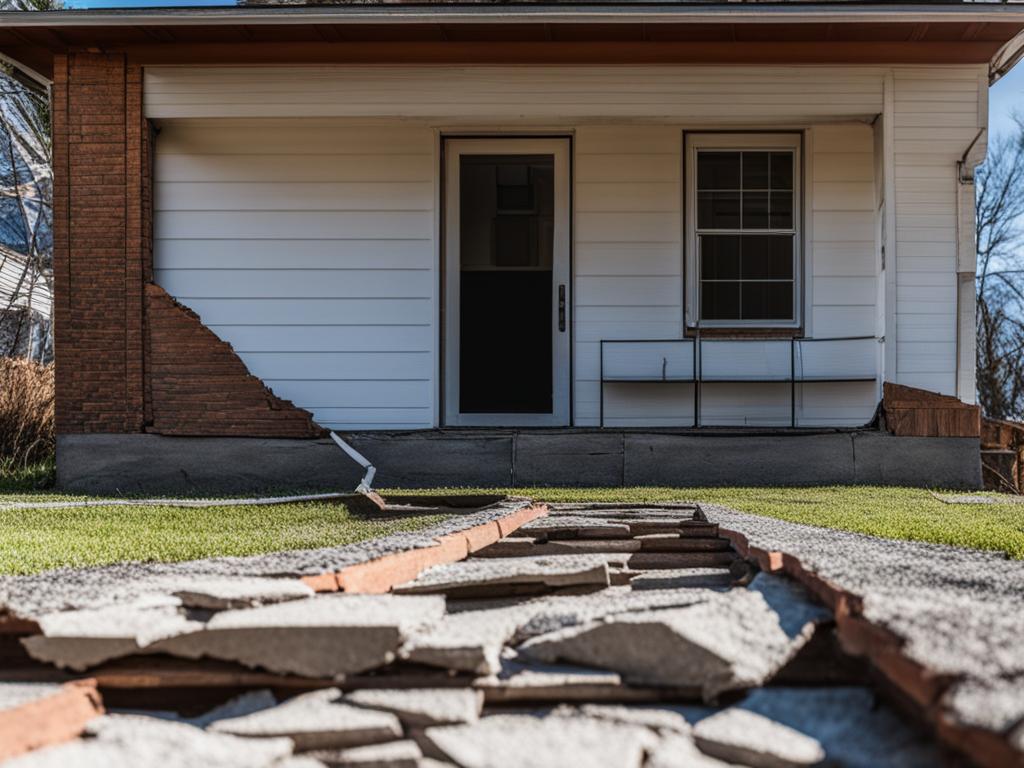
Why Regular Maintenance and Inspections are Important
Regular maintenance and inspections are crucial for homeowners to prevent and detect slab leaks before they cause significant damage. Taking proactive measures to maintain your plumbing system can help reduce the risk of slab leaks and ensure that your homeowners insurance coverage remains intact. By identifying and addressing potential issues early on, you can avoid costly repairs and potential disruptions to your daily life.
One of the key reasons why regular maintenance is important is to detect any warning signs of a slab leak. These signs may include increased water bills, the sound of water running when no faucets are on, loss of water pressure, or damp baseboards and wet carpets. If you notice any of these indicators, it’s essential to hire a professional plumber who can conduct a thorough inspection and identify the source of the problem.
During inspections, professionals can use specialized equipment, such as leak detection devices and thermal imaging cameras, to locate and identify slab leaks accurately. They can also assess the condition of your plumbing system and recommend any necessary repairs or maintenance tasks to prevent future leaks. Regular inspections every few years can provide peace of mind and help you catch any potential issues early on, saving you both time and money in the long run.
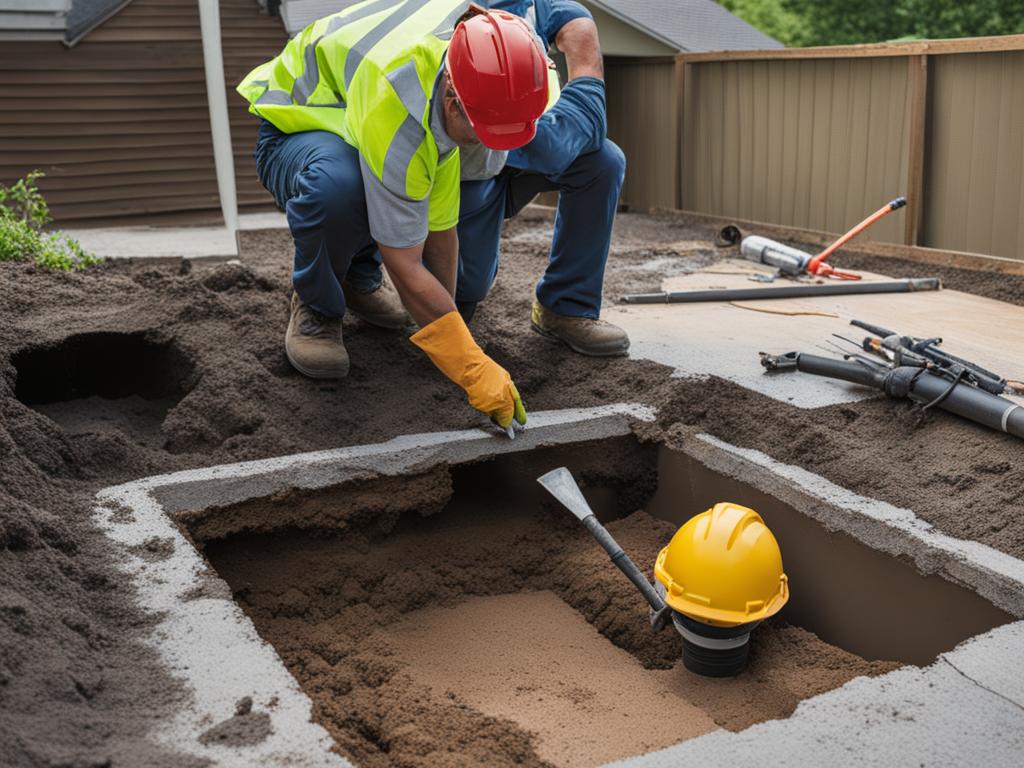
Benefits of Regular Maintenance and Inspections:
- Early detection of slab leaks, preventing further damage to your home’s structure and belongings.
- Cost savings by addressing minor plumbing issues before they escalate into major repairs.
- Preservation of your homeowners insurance coverage, as neglecting maintenance responsibilities could result in coverage exclusions.
- Increased property value and marketability, as a well-maintained plumbing system is an attractive feature for potential buyers.
Remember that regular maintenance and inspections should be carried out by qualified professionals who have the expertise and experience to identify and address potential slab leaks. By prioritizing regular maintenance, you can ensure the longevity of your plumbing system and minimize the risk of costly repairs and insurance claims in the future.
Working with Your Insurance Provider
If you believe you have a slab leak and want to determine if it’s covered by your homeowners insurance, it’s recommended to contact your insurance provider. They can review your policy, explain the coverage, and answer any questions you may have about potential claims. It’s important to understand the terms, conditions, and limitations of your policy before proceeding with any repairs or claims.
When contacting your insurance provider, be prepared with relevant information, such as the date the leak was discovered, any documentation or photos of the damage, and details about the potential cause of the leak. This will help expedite the claims process and ensure accurate information is provided to your insurer.
Determining Coverage
Your insurance provider will assess the cause of the slab leak and determine if it falls under a covered peril in your policy. If the cause is deemed covered, your provider can guide you through the claims process, including filing necessary paperwork and providing estimates for repairs.
Keep in mind that insurance coverage for slab leaks can vary depending on your policy and insurer. Some policies may have specific provisions or exclusions for slab leaks, so it’s important to review your policy carefully and ask any questions you may have. Your insurance provider can help you understand the extent of your coverage and any applicable deductibles or limits.
| Steps to Work with Your Insurance Provider |
|---|
| Contact your insurance provider |
| Provide relevant information and documentation |
| Discuss the cause of the slab leak |
| Review your policy for coverage details |
| File necessary paperwork and claims |
By working closely with your insurance provider, you can navigate the claims process and ensure that you receive the appropriate coverage for your slab leak repair. Remember to keep records of all communication and documentation related to the claim, including estimates, invoices, and any payments received.
Factors to Consider Before Filing a Claim
Before filing a claim for slab leak repair, there are several factors you should consider to make an informed decision. By taking these factors into account, you can determine if filing a claim is the right course of action for your situation.
1. Review your insurance policy
Start by reviewing your homeowners insurance policy to understand the coverage it provides for slab leaks. Look for specific language regarding slab leak insurance and slab leak repair coverage. Pay close attention to the deductible amount and any potential impact on your insurance rates if you file a claim.
2. Assess the cost of repairs
Next, assess the cost of repairing the slab leak. Consider factors such as the extent of the damage, the location of the leak, and the cost of labor in your area. Compare the cost of repairs to your insurance deductible to determine if filing a claim is financially beneficial. Keep in mind that multiple claims related to water damage and foundation issues can result in higher insurance rates in the long run.
3. Consult with your insurance provider
When in doubt, it’s always a good idea to consult with your insurance provider. Contact them to discuss your specific situation and get clarification on your coverage. They can provide valuable insights, answer any questions you may have, and guide you through the claims process.
By carefully considering these factors, you can make an informed decision about whether to file a claim for slab leak repair. Remember, it’s important to weigh the potential benefits against the potential costs and long-term implications for your insurance rates.
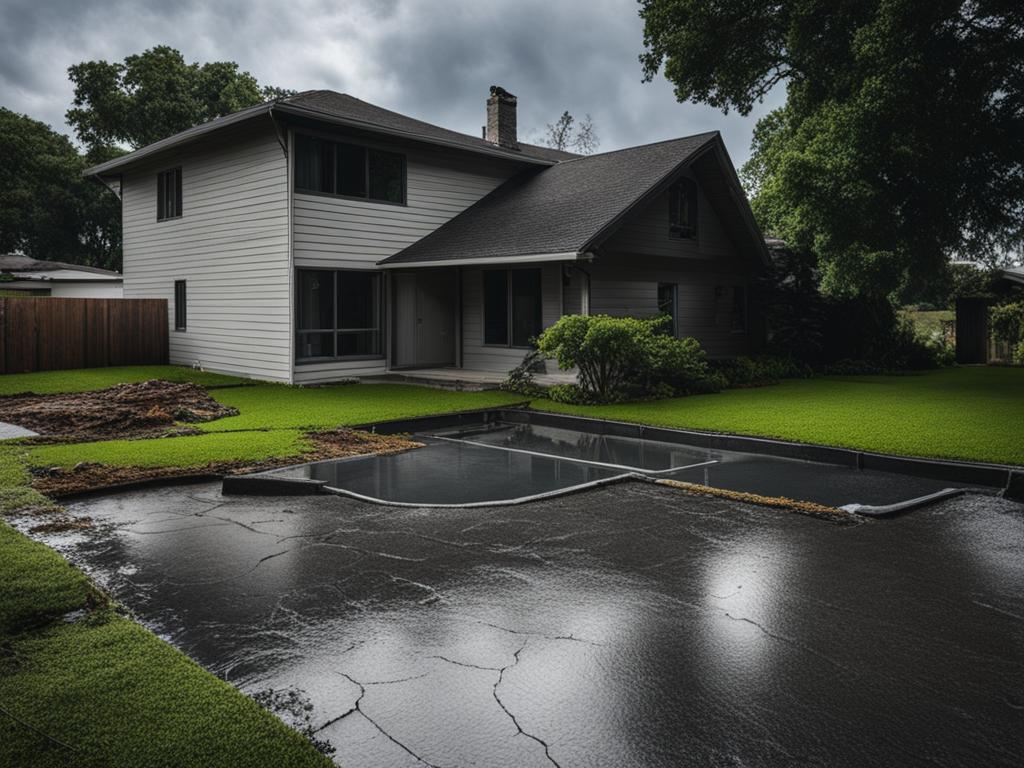
Conclusion
Understanding your homeowners insurance coverage for slab leaks is crucial to ensure you’re protected in the event of a leak. While homeowners insurance may cover the cost of tearing out and replacing the slab and repairing water damage, it typically does not cover the cost of fixing the broken pipes.
Regular maintenance and inspections can help prevent slab leaks and ensure the longevity of your plumbing system. By taking proactive measures to maintain your plumbing system, you can reduce the risk of slab leaks and potentially avoid costly repairs.
Before filing a claim for slab leak repair, it’s important to consider several factors. Review your insurance policy to understand the coverage, deductible, and potential impact on your rates. Assess the cost of repairs and weigh it against your deductible to determine if filing a claim is financially beneficial. Additionally, consider the long-term implications of filing a claim, as multiple claims related to water damage and foundation issues can result in higher insurance rates.
In conclusion, homeowners insurance for slab leaks can provide coverage for tearing out and replacing the slab and repairing water damage. However, it’s crucial to review your policy, consult with your insurance provider, and weigh the cost of repairs before deciding to file a claim. By understanding your coverage and taking necessary preventive measures, you can protect your home and avoid potential financial burdens.
FAQ
Does homeowners insurance cover slab leak repair?
A homeowners insurance policy may help pay for damage caused by a slab leak, depending on what caused the leak to occur. Covered perils typically include risks like fire, wind, explosions, and falling objects.
What does dwelling coverage help pay for in relation to a slab leak?
Dwelling coverage can help pay to repair damage to the structure of your home, including removing and replacing the slab.
What does personal property coverage help pay for in relation to a slab leak?
Personal property coverage can help pay to repair damage to belongings in your home that were affected by the slab leak.
Are slab leaks covered under homeowners insurance if they are caused by maintenance issues or wear and tear?
Homeowners insurance generally does not cover slab leaks that are caused by gradual issues or wear and tear. This includes situations where tree roots damage the plumbing or when plumbing lines are past their prime.
How can I detect a slab leak?
Signs of a slab leak include increased water bills, the sound of water running, loss of water pressure, damp baseboards or wet carpets and floors. It’s important to hire a professional to determine if there is a leak and its source.
How much does it cost to repair a slab leak?
The average cost to repair a slab leak is around $2,515 according to 2022 cost data. However, this cost can vary depending on various factors such as the extent of the damage, the location of the slab leak, and the cost of labor in your area.
Does homeowners insurance cover foundation issues related to slab leaks?
Homeowners insurance may cover the cost of foundation issues, including slab cracks and leaks, if the cause of the damage is a covered peril.
Why is regular maintenance and inspections important for preventing slab leaks?
Regular maintenance and inspections can help prevent and detect slab leaks before they cause significant damage. It’s important to have your slab inspected every few years by a professional who can identify any potential issues or warning signs.
How can I work with my insurance provider regarding slab leak coverage?
If you believe you have a slab leak and want to determine if it’s covered by your homeowners insurance, it’s recommended to contact your insurance provider. They can review your policy, explain the coverage, and answer any questions you may have about potential claims.
What factors should I consider before filing a claim for slab leak repair?
Before filing a claim for slab leak repair, it’s important to review your insurance policy to understand the coverage, deductible, and potential impact on your rates. Assess the cost of repairs and weigh it against your deductible to determine if filing a claim is financially beneficial.

